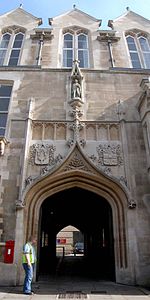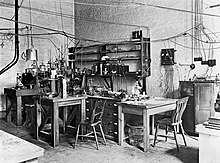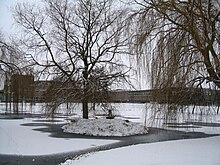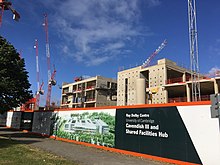Cavendish Laboratory
 Cavendish plaque at original New Museums Site | |
| Established | 1874 |
|---|---|
| Affiliation | University of Cambridge |
| Head of department | Mete Atature[1] |
| Location | , United Kingdom 52°12′33″N 00°05′33″E / 52.20917°N 0.09250°E |
| Cavendish Professor of Physics | Vacant |
| Website | www |
The Cavendish Laboratory is the Department of Physics at the University of Cambridge, and is part of the School of Physical Sciences. The laboratory was opened in 1874 on the New Museums Site as a laboratory for experimental physics and is named after the British chemist and physicist Henry Cavendish. The laboratory has had a huge influence on research in the disciplines of physics and biology.
The laboratory moved to its present site in West Cambridge in 1974.
As of 2019[update], 30 Cavendish researchers have won Nobel Prizes.[2] Notable discoveries to have occurred at the Cavendish Laboratory include the discovery of the electron, neutron, and structure of DNA.
Founding


The Cavendish Laboratory was initially located on the New Museums Site, Free School Lane, in the centre of Cambridge. It is named after British chemist and physicist Henry Cavendish[3][4] for contributions to science[5] and his relative William Cavendish, 7th Duke of Devonshire, who served as chancellor of the university and donated funds for the construction of the laboratory.[6]
Professor
Physics
Several important early physics discoveries were made here, including the discovery of the electron by J.J. Thomson (1897) the Townsend discharge by John Sealy Townsend, and the development of the cloud chamber by C.T.R. Wilson.
Ernest Rutherford became Director of the Cavendish Laboratory in 1919. Under his leadership the neutron was discovered by James Chadwick in 1932, and in the same year the first experiment to split the nucleus in a fully controlled manner was performed by students working under his direction; John Cockcroft and Ernest Walton.
Physical chemistry
Physical Chemistry (originally the department of Colloid Science led by Eric Rideal) had left the old Cavendish site, subsequently locating as the Department of Physical Chemistry (under RG Norrish) in the then new chemistry building with the Department of Chemistry (led by Lord Todd) in Lensfield Road: both chemistry departments merged in the 1980s.
Nuclear physics
In World War II the laboratory carried out research for the
Biology
The Cavendish Laboratory has had an important influence on biology, mainly through the application of X-ray crystallography to the study of structures of biological molecules. Francis Crick already worked in the Medical Research Council Unit, headed by Max Perutz[10][11] and housed in the Cavendish Laboratory, when James Watson came from the United States and they made a breakthrough in discovering the structure of DNA. For their work while in the Cavendish Laboratory, they were jointly awarded the Nobel Prize in Physiology or Medicine in 1962, together with Maurice Wilkins of King's College London, himself a graduate of St. John's College, Cambridge.
The discovery was made on 28 February 1953; the first Watson/Crick paper appeared in
Present site


Due to overcrowding in the old buildings, it moved to its present site in West Cambridge in the early 1970s.[13] It is due to move again to a third site currently under construction in West Cambridge.[14]
Nobel laureates at the Cavendish
- John William Strutt, 3rd Baron Rayleigh (Physics, 1904)
- Sir J. J. Thomson (Physics, 1906)
- Ernest Rutherford (Chemistry, 1908)
- Sir William Lawrence Bragg(Physics, 1915)
- Charles Glover Barkla (Physics, 1917)
- Francis William Aston (Chemistry, 1922)
- Charles Thomson Rees Wilson[15] (Physics, 1927)
- Arthur Compton (Physics, 1927)
- Sir Owen Willans Richardson (Physics, 1928)
- Sir James Chadwick (Physics, 1935)
- Sir George Paget Thomson[16] (Physics, 1937)
- Sir Edward Victor Appleton (Physics, 1947)
- Patrick Blackett, Baron Blackett(Physics, 1948)
- Sir John Cockcroft[17] (Physics, 1951)
- Ernest Walton (Physics, 1951)
- Francis Crick (Physiology or Medicine, 1962)
- James Watson (Physiology or Medicine, 1962)
- Max Perutz (Chemistry, 1962)
- Sir John Kendrew (Chemistry, 1962)
- Dorothy Hodgkin[18] (Chemistry, 1964)
- Brian Josephson (Physics, 1973)
- Sir Martin Ryle (Physics, 1974)
- Antony Hewish (Physics, 1974)
- Sir Nevill Francis Mott (Physics, 1977)
- Philip Warren Anderson(Physics, 1977)
- Pyotr Kapitsa (Physics, 1978)
- Allan McLeod Cormack(Physiology or Medicine, 1979)
- Mohammad Abdus Salam(Physics, 1979)
- Sir Aaron Klug[19] (Chemistry, 1982)
- Didier Queloz (Physics, 2019)
Cavendish Professors of Physics
The Cavendish Professors were the heads of the department until the tenure of Sir Brian Pippard, during which period the roles separated.
- James Clerk Maxwell FRS FRSE 1871–1879
- John William Strutt, 3rd Baron Rayleigh[20] 1879–1884
- Sir Joseph J. ThomsonFRS 1884–1919
- Ernest Rutherford FRS, 1st Baron Rutherford of Nelson 1919–1937
- Sir William Lawrence BraggCH OBE MC FRS 1938–1953
- Sir Nevill Francis Mott CH FRS 1954–1971
- Sir Brian Pippard FRS[21] 1971–1984
- Sir Sam Edwards FRS 1984–1995
- Sir Richard Friend FRS FREng[22] 1995–2020
- Vacant 2020–present
Heads of department
- Professor Sir Alan Cook FRS FRSE 1979-1984
- Professor Archie HowieCBE FRS 1989-1997
- Professor Malcolm Longair† CBE FRS FRSE 1997-2005
- Professor Peter Littlewood FRS 2005-2011
- Professor James Stirling† CBE FRS 2011-2013
- Professor Michael Andrew Parker2013 - 2023
- Professor Mete Atature2023 -
† Jacksonian Professors of Natural Philosophy
Cavendish Groups
Areas in which the Laboratory has been influential include:-
- Shoenberg Laboratory for Quantum Matter,Gil Lonzarich[24]
- Superconductivity Josephson junction, led by Brian Pippard[21]
- Theory of Condensed Matter,[25] which is the dominant theoretical group.
- Electron Microscopy Group [26] led by Archie Howie
- Radio Astronomy (led by Martin Ryle[27] and Antony Hewish), with the Cavendish Astrophysics Groups telescopes being based at Mullard Radio Astronomy Observatory.
- Semiconductor Physics[28]
- Atomic, Mesoscopic and Optical Physics (AMOP) Group[29] led by Zoran Hadzibabic
- Nanophotonics group[30] led by Jeremy Baumberg
- Structure and Dynamics Group,[31] led by Jacqui Cole
- Laboratory for Scientific Computing[32] led by Nikos Nikiforakis
- Biological and Soft Systems Group[33] led by Pietro Cicuta
Cavendish staff
As of 2023[update] the laboratory is headed by Mete Atature[1] and the Cavendish Professor of Physics is Sir Richard Friend.[22]
Notable senior academic staff
As of 2015[update] senior academic staff (Professors or Readers) include:[34]
- Jeremy Baumberg FRS, Professor of Nanoscience and Fellow of Jesus College, Cambridge
- Jacqui Cole, Professor of Molecular Engineering
- Athene Donald FRS, Professor of Experimental Physics, Master of Churchill College, Cambridge
- Sir FREng, Cavendish Professor of Physics and Fellow of St John's College, Cambridge
- Stephen Gull, University Professor of Physics
- Sir Michael Pepper FRS, Kt, Honorary Professor of Pharmaceutical Science in the University of Otago, New Zealand
- Didier Queloz FRS, professor at the Battcock Centre for Experimental Astrophysics
- James Floyd Scott FRS, professor and director of research
- Ben Simons FRS, Herchel Smith Professor of Physics
- Henning Sirringhaus FRS, Hitachi Professor of Electron Device Physics and head of Microelectronics and Optoelectronics Group
- Sarah Teichmann FRS, principal research associate and Fellow of Trinity College, Cambridge
Notable emeritus professors
The Cavendish is home to a number of emeritus scientists, pursuing their research interests in the laboratory after their formal retirement.[34]
- Mick Brown FRS, emeritus professor
- Volker Heine, FRS, emeritus professor
- Brian Josephson, FRS, emeritus professor
- Archibald Howie, FRS, emeritus professor
- Malcolm Longair, CBE, FRS, FRSE, Emeritus Jacksonian Professor of Natural Philosophy
- Gil Lonzarich, FRS Emeritus Professor of Condensed Matter Physics and professorial fellow at Trinity College, Cambridge
- Bryan Webber, FRS Emeritus Professor of Theoretical High Energy Physics and professorial fellow at Emmanuel College, Cambridge
Other notable alumni
Besides the Nobel Laureates, the Cavendish has many distinguished alumni including:
- Louis Harold Gray
- Richard Edwin Hills
- Olga Kennard
- Andrew D. Maynard at Arizona State University
- Bernard Roberts
- John Rodenburg
- Henry Snaith
- Evan James Williams
- Richard Jones
References
- ^ a b "Professor of Physics, Fellow, Director of Studies and Tutor at St. John's College". University of Cambridge. 3 October 2023.
- ^ "Nobel Prize Winners who have worked for considerable periods of time at the Cavendish Laboratory". Archived from the original on 12 January 2006.
- ^ "The History of the Cavendish". University of Cambridge. 13 August 2013. Archived from the original on 8 April 2013. Retrieved 17 August 2015.
- ^ "A history of the Cavendish laboratory, 1871-1910". 1910.
- ^ "Professor and Laboratory " Archived 2012-01-18 at the Wayback Machine, Cambridge University
- ^ The Times, 4 November 1873, p. 8
- ^ Dennis Moralee, "Maxwell's Cavendish" Archived 2013-09-15 at the Wayback Machine, from the booklet "A Hundred Years and More of Cambridge Physics"
- ^ "James Clerk Maxwell" Archived 2015-02-24 at the Wayback Machine, Cambridge University
- ^ "Austin Wing of the Cavendish Laboratory". Archived from the original on 21 November 2012.
- PMID 15768489.
- PMID 11914731.
- ISBN 978-0-87969-798-3
- ^ "West Cambridge Site Location of the Cavendish Laboratory on the University map". Archived from the original on 25 February 2017. Retrieved 12 July 2014.
- ^ "Cavendish III — Department of Physics". www.phy.cam.ac.uk. Archived from the original on 12 July 2019. Retrieved 29 July 2019.
- S2CID 73384198.
- .
- S2CID 57116624.
- S2CID 61764553.
- PMID 15003624.
- ^ O'Connor, John J.; Robertson, Edmund F., "John William Strutt", MacTutor History of Mathematics Archive, University of St Andrews
- ^ .
- ^ a b "FRIEND, Sir Richard (Henry)". Who's Who. Vol. 2015 (online Oxford University Press ed.). A & C Black. (Subscription or UK public library membership required.)
- ^ "Quantum Matter group". Archived from the original on 18 June 2008. Retrieved 16 June 2008.
- ^ Gilbert George Lonzarich's publications indexed by the Scopus bibliographic database. (subscription required)
- ^ "Theory of Condensed Matter group". Archived from the original on 11 August 2015. Retrieved 27 July 2015.
- ^ "Electron Microscopy Group". Archived from the original on 25 March 2013. Retrieved 6 August 2013.
- S2CID 71422161.
- ^ "Semiconductor Physics Group". Archived from the original on 8 October 2003. Retrieved 16 June 2008.
- ^ "AMOP group". Archived from the original on 27 April 2013. Retrieved 2 March 2013.
- ^ "Nanophotonics Group". Archived from the original on 15 February 2013. Retrieved 2 March 2013.
- ^ "Structure and Dynamics Group". Archived from the original on 24 November 2015. Retrieved 22 November 2018.
- ^ "Laboratory for Scientific Computing". Archived from the original on 23 March 2013. Retrieved 2 March 2013.
- ^ "Biological and Soft Systems". Archived from the original on 14 February 2021. Retrieved 5 February 2021.
- ^ a b "Academic staff at the Cavendish Laboratory". University of Cambridge. Archived from the original on 12 October 2014.
Further reading
- Longair, Malcolm (2016). Maxwell's Enduring Legacy: A Scientific History of the Cavendish Laboratory. Cambridge University Press. ISBN 978-1-107-08369-1.
External links
![]() Media related to Cavendish Laboratory at Wikimedia Commons
Media related to Cavendish Laboratory at Wikimedia Commons
- Austin Memories—History of Austin and Longbridge Cavendish Article

